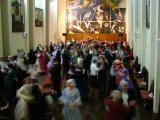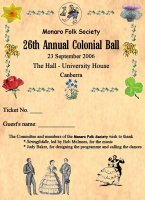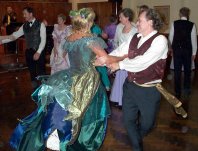26th MFS Colonial Ball : University
House, 23 September 2006
In 2006, after many years at Albert Hall, the Ball returned to the Australian National
University, where the first four Balls had been held in the Refectory on 7 March
1981, 6 March 1982, 24 September 1983 and 22 September 1984.
 This
year the Ball was held, not in the Refectory, but in The Hall and Common Room of University House. The House was constructed
in the early 1950s and was opened by the Duke of Edinburgh in February 1954 during Queen
Elizabeth II's post-coronation visit to Australia.
This
year the Ball was held, not in the Refectory, but in The Hall and Common Room of University House. The House was constructed
in the early 1950s and was opened by the Duke of Edinburgh in February 1954 during Queen
Elizabeth II's post-coronation visit to Australia.
The venue is out of the ordinary, the Hall featuring major works by Leonard French. The
eye is first drawn to the 9m square Regeneration (1971-72) at the
head of the Hall, but then one almost immediately notices the stylistic progression
leading toward that work: the artist French's 10-painting Journey series,
completed in 1970, lines the other three walls, together with several of his working
drawings and associated works and memorabilia. Glimpses of the paintings can be caught in
the background of some photos of the Ball.
 The
music for the Ball was provided by Stringfiddle, who also played at the 1992 and
1993 Balls. For the 2006 Ball, Stringfiddle comprised: Bob McInnes on fiddle,
Polly Garland on keyboard, Chris Stone on fiddle, and Jennifer Strutt on double bass. The
dance programme below was designed and called by Judy Baker, who was a driving force in
starting the entire series in 1981. Supper was catered by University House.
The
music for the Ball was provided by Stringfiddle, who also played at the 1992 and
1993 Balls. For the 2006 Ball, Stringfiddle comprised: Bob McInnes on fiddle,
Polly Garland on keyboard, Chris Stone on fiddle, and Jennifer Strutt on double bass. The
dance programme below was designed and called by Judy Baker, who was a driving force in
starting the entire series in 1981. Supper was catered by University House.
Planning for the 2006 Ball began in late 2005, and kicked into high gear in March 2006.
There were two main issues for the Colonial Ball Working Group to decide:- the programme,
and the venue.
The objective was to create an evening of grace and elegance, with a programme of
dances that would be interesting but not overly challenging, so that they could be enjoyed
by dancers with a variety of levels of experience, and not of such energy as to detract
from the glamorous presentation or to overly tire people. Judy Baker's experience was
invaluable in designing such a programme, and Stringfiddle's musical style proved
to be entirely appropriate.
Finding a venue was more difficult. Initially, Albert Hall was the obvious choice and,
despite some misgivings about its generally run-down condition, it was booked in late
March. However, although its management assured the Working Group that the booking was
guaranteed for 23 September, it was unable to indicate what the hiring charge would
be, apparently because the contract to administer the Albert Hall was still in process of
being offered for tender. Consequently, a backup venue was sought. After looking at more
than a dozen possibilities, the WG was dismayed to find how few venues there are in
Canberra that are suitable for large dance events such as our Ball. However, the WG did
come up with a shortlist of two reserve venues, both of which were booked as such. One of
these was University House. When no progress had been made by the end of July on agreeing
a hiring charge for Albert Hall, University House was then confirmed as the venue, and
Albert Hall and the alternate reserve venue were cancelled.
A total of 96 dancers booked for the Ball - this was fortunate, as a nominal cap of 100
had been set to ensure the floor was not overcrowded. Even more fortunate, those 96
consisted of exactly equal numbers of ladies and gentlemen!! A further 12
"civilian" guests, including the band and caller and several helpers, were also
catered for.
On arrival, the guests mingled for a while in the Common Room and anteroom, filling out
dance cards and generally catching up with and admiring each other. Then, on the stroke of
8pm, the Grand March formed up from the Common Room and proceeded into the Hall, to the
strains of a medley of tunes evoking the theme of the principal Four Quarters
of Australia's colonial dance parentage - British Grenadiers, Star Of The County Down,
Scots Wha Hae, Men Of Harlech, Minstrel Boy, Bluebells Of Scotland, all linked by Napoleon's
Grand March. After a programme of 18 dances (including an off-programme rerun of the
ever-popular Strip The Willow), at about midnight the music segued into Auld
Lang Syne.
The participants obviously had a great time, and were forthcoming in their compliments,
so the organisers are very happy with the result.
 The following day, despite
bitter winds and patchy rain, there was a good turnout of dancers at the Recovery Picnic
at Lanyon Homestead. Most dressed for the part (colonial daywear, not the
previous night's "best rig") and, accompanied by MFS musicians, they performed a
short set of bush dances to the delight of visitors to Lanyon's annual Woolfest -
until the rain drove us into shelter.
The following day, despite
bitter winds and patchy rain, there was a good turnout of dancers at the Recovery Picnic
at Lanyon Homestead. Most dressed for the part (colonial daywear, not the
previous night's "best rig") and, accompanied by MFS musicians, they performed a
short set of bush dances to the delight of visitors to Lanyon's annual Woolfest -
until the rain drove us into shelter.
See below for other reports and photos.
| The Flyer & Booking Form |
The Programme |
  The Dance Card
 |
Grand March
1. Cheshire Rounds
2. Pride Of Erin
3. Thady You Gander
4. Valeta
5. Siege Of Carrick
6. Four Sisters Barn Dance
7. Colonials Quadrille
8. Soldier’s Joy
9. St Bernard’s Waltz
10. Strip The Willow
Supper
11. Waltz Country Dance
12. Waves Of Tory
13. Rakes Of Mallow
14. Willow Tree
15. Round Reel Of Eight
16. Parma Waltz
17. Virginia Reel
18. Barn Dance
Auld Lang Syne |
"It is just like a fairytale…"  |
 
Prizewinners |
Photo Gallery |
A
Great Big Thank You |
Created 14 August 2006 : Last updated 01 March 2011.
 This
year the Ball was held, not in the Refectory, but in The Hall and Common Room of University House. The House was constructed
in the early 1950s and was opened by the Duke of Edinburgh in February 1954 during Queen
Elizabeth II's post-coronation visit to Australia.
This
year the Ball was held, not in the Refectory, but in The Hall and Common Room of University House. The House was constructed
in the early 1950s and was opened by the Duke of Edinburgh in February 1954 during Queen
Elizabeth II's post-coronation visit to Australia.






